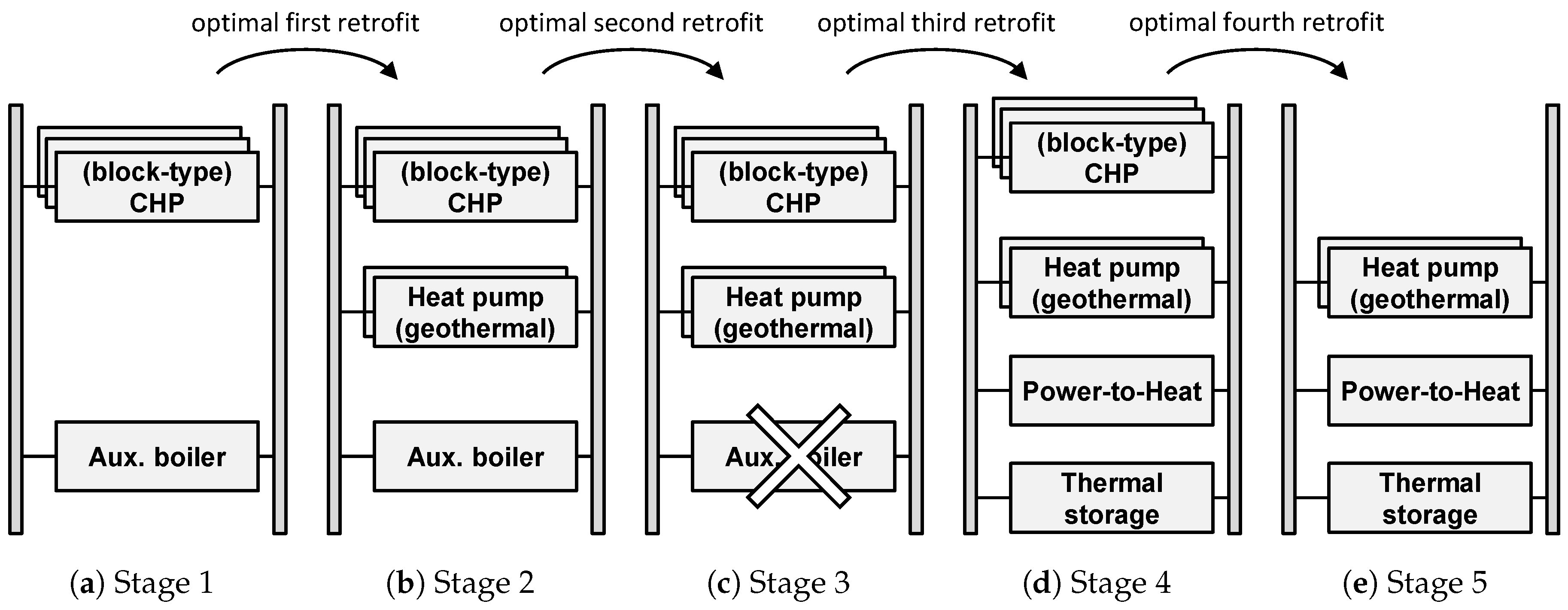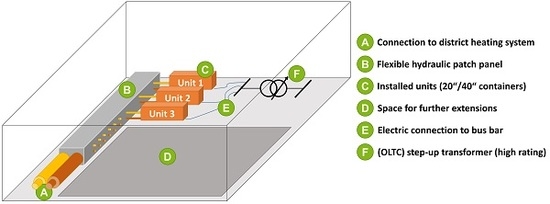Adaptable Energy Systems Integration by Modular, Standardized and Scalable System Architectures: Necessities and Prospects of Any Time Transition
Abstract
:1. Introduction
1.1. Literature Review of the Investment Planning Problem
1.2. Research Gap and Contribution of This Work
- A technical concept building on modularity, standardization and scalability is presented at a manageable level of abstraction but including detailed notes on implementation (Section 2).
- The notion of adaptability is introduced in the context of sustainable energy infrastructure (Section 2).
- A case study shows an exemplary system’s evolution, which is enabled by the presented architecture (Section 3).
- Positive technical, strategical and societal prospects are discussed (Section 4).
- The connection to other concepts and visions of energy systems integration is shown to highlight compatibility and thus direct implementability (Appendix A).
2. Envisioned Technical System Architecture of Future Infrastructure and Supply
2.1. Overview of Basic Elements of the Architecture
2.2. Physical Modularity and Standardization of Conversion and Storage Units
2.3. Integration into the Electric Grid
2.4. Hydraulic Integration into the District Heating System
2.5. Spatial Integration into the Urban Built Environment (Spatial Planning Perspective)
3. Exemplary Hypothetical Evolution of a Realized System Over Decades
4. Technical, Strategical and Societal Prospects of the Introduced Adaptability
4.1. Adaptability as an Indicator for the Sustainability of Systems
- Lower cost of redevelopment and redesign,
- lower cost of installation and system integration,
- compatibility with future markets, and
- local concentration, economies of scale and continuous controllability.
4.2. Lower Cost of Redevelopment and Redesign of Portfolios
4.3. Lower Cost of Installation and System Integration
4.4. Long-Term Market Compatibility
4.4.1. Access to New Markets
4.4.2. Market Compatibility by Fit: Generation Capacity and Quality
4.5. Local Concentration, Economies of Scale and Continuous Controllability
4.5.1. Local Concentration and Economies of Scale
4.5.2. Continuous Controllability by Available Real Options
4.6. Thinkable Actors for an Implementation (and Business Cases)
5. Conclusion and Outlook
5.1. Summary and Conclusions
5.2. Outlook on Future Research
Acknowledgments
Author Contributions
Conflicts of Interest
Appendix A. Analogies and Connections to Existing Architectures, System Descriptions and Concepts
Appendix A.1. Integrated Infrastructure and Supply Planning: Urban Energy Systems (UES)
Appendix A.2. Local Multi-Carrier Generation: Distributed Multi-Generation (DMG)
Appendix A.3. High Level Multi-Input-Multi-Output Systems Perspective: Energy Hub
References
- Connolly, D. Heat Roadmap Europe: Quantitative comparison between the electricity, heating, and cooling sectors for different European countries. Energy 2017, 139, 580–593. [Google Scholar] [CrossRef]
- Clegg, S.; Mancarella, P. Integrated Electrical and Gas Network Flexibility Assessment in Low-Carbon Multi-Energy Systems. IEEE Trans. Sustain. Energy 2016, 7, 718–731. [Google Scholar] [CrossRef]
- Heinen, S.; Hewicker, C.; Jenkins, N.; McCalley, J.; O’Malley, M.; Pasini, S.; Simoncini, S. Unleashing the Flexibility of Gas: Innovating Gas Systems to Meet the Electricity System’s Flexibility Requirements. IEEE Power Energy Mag. 2017, 15, 16–24. [Google Scholar] [CrossRef]
- Liu, X.; Mancarella, P. Modelling, assessment and Sankey diagrams of integrated electricity-heat-gas networks in multi-vector district energy systems. Appl. Energy 2016, 167, 336–352. [Google Scholar] [CrossRef]
- O’Malley, M.; Kroposki, B. Unlocking Flexibility: Energy Systems Integration [Guest Editorial]. IEEE Power Energy Mag. 2017, 15, 10–14. [Google Scholar] [CrossRef]
- Good, N.; Martínez Ceseña, E.A.; Mancarella, P. Business Cases. In Energy Positive Neighborhoods and Smart Energy Districts; Elsevier: Amsterdam, The Netherlands, 2017; pp. 159–226. [Google Scholar]
- Magnusson, D. Swedish district heating—A system in stagnation: Current and future trends in the district heating sector. Energy Policy 2012, 48, 449–459. [Google Scholar] [CrossRef]
- DeLlano Paz, F.; Calvo-Silvosa, A.; Antelo, S.I.; Soares, I. Energy planning and modern portfolio theory: A review. Renew. Sustain. Energy Rev. 2017, 77, 636–651. [Google Scholar] [CrossRef]
- Ioannou, A.; Angus, A.; Brennan, F. Risk-based methods for sustainable energy system planning: A review. Renew. Sustain. Energy Rev. 2017, 74, 602–615. [Google Scholar] [CrossRef]
- Favre-Perrod, P.; Kienzle, F.; Andersson, G. Modeling and design of future multi-energy generation and transmission systems. Eur. Trans. Electr. Power 2010, 20, 994–1008. [Google Scholar] [CrossRef]
- Carpaneto, E.; Chicco, G.; Mancarella, P.; Russo, A. A Decision Theory Approach to Cogeneration Planning in the Presence of Uncertainties. In Proceedings of the 2007 IEEE Lausanne Power Tech, Lausanne, Switzerland, 1–5 July 2007; pp. 1435–1440. [Google Scholar]
- Thangavelu, S.R.; Khambadkone, A.M.; Karimi, I.A. Long-term optimal energy mix planning towards high energy security and low GHG emission. Appl. Energy 2015, 154, 959–969. [Google Scholar] [CrossRef]
- Baringo, L.; Conejo, A.J. Risk-Constrained Multi-Stage Wind Power Investment. IEEE Trans. Power Syst. 2013, 28, 401–411. [Google Scholar] [CrossRef]
- Bruno, S.; Ahmed, S.; Shapiro, A.; Street, A. Risk neutral and risk averse approaches to multistage renewable investment planning under uncertainty. Eur. J. Oper. Res. 2016, 250, 979–989. [Google Scholar] [CrossRef]
- Mashayekh, S.; Stadler, M.; Cardoso, G.; Heleno, M. A mixed integer linear programming approach for optimal DER portfolio, sizing, and placement in multi-energy microgrids. Appl. Energy 2017, 187, 154–168. [Google Scholar] [CrossRef]
- Wierzbowski, M.; Lyzwa, W.; Musial, I. MILP model for long-term energy mix planning with consideration of power system reserves. Appl. Energy 2016, 169, 93–111. [Google Scholar] [CrossRef]
- Dominguez, R.; Conejo, A.J.; Carrion, M. Investing in Generation Capacity: A Multi-Stage Linear-Decision-Rule Approach. IEEE Trans. Power Syst. 2016, 31, 4784–4794. [Google Scholar] [CrossRef]
- Moshi, G.G.; Bovo, C.; Berizzi, A.; Taccari, L. Optimization of integrated design and operation of microgrids under uncertainty. In Proceedings of the 2016 Power Systems Computation Conference (PSCC), Genoa, Italy, 20–24 June 2016; pp. 1–7. [Google Scholar]
- Von Haebler, J.; Erlemeyer, F.; Rehtanz, C.; Blanco, G. Modelling of efficient distributed generation porfolios using a multiobjective optimization approach. In Proceedings of the 2017 IEEE Manchester PowerTech, Manchester, UK, 18–22 June 2017; pp. 1–6. [Google Scholar]
- Wang, H.; Huang, J. Cooperative Planning of Renewable Generations for Interconnected Microgrids. IEEE Trans. Smart Grid 2016, 7, 2486–2496. [Google Scholar] [CrossRef]
- Chis, A.; Koivunen, V. Coalitional game based cost optimization of energy portfolio in smart grid communities. IEEE Trans. Smart Grid 2017, 1. [Google Scholar] [CrossRef]
- Franco, J.F.; Rider, M.J.; Romero, R. Robust Multi-Stage Substation Expansion Planning Considering Stochastic Demand. IEEE Trans. Power Syst. 2016, 31, 2125–2134. [Google Scholar] [CrossRef]
- Huang, Y.H.; Wu, J.H.; Hsu, Y.J. Two-stage stochastic programming model for the regional-scale electricity planning under demand uncertainty. Energy 2016, 116, 1145–1157. [Google Scholar] [CrossRef]
- Boomsma, T.K.; Meade, N.; Fleten, S.E. Renewable energy investments under different support schemes: A real options approach. Eur. J. Oper. Res. 2012, 220, 225–237. [Google Scholar] [CrossRef]
- Min, K.J.; Wang, C.H. Generation planning for inter-related generation units: A real options approach. In Proceedings of the 2000 Power Engineering Society Summer Meeting (Cat. No.00CH37134), Seattle, WA, USA, 16–20 July 2000; pp. 2261–2265. [Google Scholar]
- Martínez Ceseña, E.A.; Capuder, T.; Mancarella, P. Flexible Distributed Multienergy Generation System Expansion Planning Under Uncertainty. IEEE Trans. Smart Grid 2016, 7, 348–357. [Google Scholar] [CrossRef]
- Geidl, M.; Koeppel, G.; Favre-Perrod, P.; Klockl, B.; Andersson, G.; Frohlich, K. Energy hubs for the future. IEEE Power Energy Mag. 2007, 5, 24–30. [Google Scholar] [CrossRef]
- International Organization for Standardization. ISO 668:2013 Series 1 Freight Containers—Classification, Dimensions and Ratings; International Organization for Standardization: Geneva, Switzerland, 2013. [Google Scholar]
- Martin, C. The Packaging of Efficiency in the Development of the Intermodal Shipping Container. Mobilities 2014, 9, 432–451. [Google Scholar] [CrossRef]
- Van Erdeweghe, S.; van Bael, J.; Laenen, B.; D’haeseleer, W. “Preheat-parallel” configuration for low-temperature geothermally-fed CHP plants. Energy Convers. Manag. 2017, 142, 117–126. [Google Scholar] [CrossRef]
- Stevenson, A. Oxford Dictionary of English, 3rd ed.; Oxford University Press: Oxford, UK, 2011. [Google Scholar]
- Wiendahl, H.P.; ElMaraghy, H.A.; Nyhuis, P.; Zäh, M.F.; Wiendahl, H.H.; Duffie, N.; Brieke, M. Changeable Manufacturing - Classification, Design and Operation. CIRP Ann. 2007, 56, 783–809. [Google Scholar] [CrossRef]
- Mancarella, P. MES (multi-energy systems): An overview of concepts and evaluation models. Energy 2014, 65, 1–17. [Google Scholar] [CrossRef]
- Chicco, G.; Mancarella, P. Distributed multi-generation: A comprehensive view. Renew. Sustain. Energy Rev. 2009, 13, 535–551. [Google Scholar] [CrossRef]
- Geidl, M. Integrated Modeling and Optimization of Multi-Carrier Energy Systems. Ph.D. Thesis, ETH Zürich, Zürich, Switzerland, 2007. [Google Scholar]
- Keirstead, J.; Shah, N. Urban Energy Systems: An Integrated Approach; Routledge: Abingdon, UK, 2013. [Google Scholar]
- ASUE. BHKW-Kenndaten 2014/2015: Module, Anbieter, Kosten; ASUE: Yerevan, Armenia, 2014. [Google Scholar]
- Evans, R. Environmental and economic implications of small-scale CHP. Energy Policy 1993, 21, 79–91. [Google Scholar] [CrossRef]
- Lantz, M. The economic performance of combined heat and power from biogas produced from manure in Sweden—A comparison of different CHP technologies. Appl. Energy 2012, 98, 502–511. [Google Scholar] [CrossRef]
- Hinker, J.; Myrzik, J.M.A.; Witte, N.; Heinzel, A. Analysis of the interdependencies of the socio-technical parameters of energy supply in urban quarters. In Proceedings of the Internet der Dinge—VDE Kongress 2016, Mannheim, Germany, 7–8 November 2016. [Google Scholar]
- Hoffman, S.M.; High-Pippert, A. From private lives to collective action: Recruitment and participation incentives for a community energy program. Energy Policy 2010, 38, 7567–7574. [Google Scholar] [CrossRef]
- Söderholm, P.; Wårell, L. Market opening and third party access in district heating networks. Energy Policy 2011, 39, 742–752. [Google Scholar] [CrossRef]
- Keirstead, J.; Samsatli, N.; Shah, N.; Weber, C. The impact of CHP (combined heat and power) planning restrictions on the efficiency of urban energy systems. Energy 2012, 41, 93–103. [Google Scholar] [CrossRef]










| Key Element of This Architecture | Note on Physical Implementation | Changeability Enablers [32] | ||
|---|---|---|---|---|
| Adaptability | Scalability, Modularity | Block-type units in intermodal containers (as defined in ISO 668 [28]) | Scalability Modularity Mobility | Transformability |
| Standardization | Hydraulic matrix setup and electric grid connection | Compatibility | ||
| Defined connectors and outlets for all units | ||||
| Inherent feature of electric power and heat (commodities) | Universality |
© 2018 by the authors. Licensee MDPI, Basel, Switzerland. This article is an open access article distributed under the terms and conditions of the Creative Commons Attribution (CC BY) license (http://creativecommons.org/licenses/by/4.0/).
Share and Cite
Hinker, J.; Wohlfahrt, T.; Drewing, E.; Contreras Paredes, S.F.; Mayorga González, D.; Myrzik, J.M.A. Adaptable Energy Systems Integration by Modular, Standardized and Scalable System Architectures: Necessities and Prospects of Any Time Transition. Energies 2018, 11, 581. https://doi.org/10.3390/en11030581
Hinker J, Wohlfahrt T, Drewing E, Contreras Paredes SF, Mayorga González D, Myrzik JMA. Adaptable Energy Systems Integration by Modular, Standardized and Scalable System Architectures: Necessities and Prospects of Any Time Transition. Energies. 2018; 11(3):581. https://doi.org/10.3390/en11030581
Chicago/Turabian StyleHinker, Jonas, Thomas Wohlfahrt, Emily Drewing, Sergio Felipe Contreras Paredes, Daniel Mayorga González, and Johanna M. A. Myrzik. 2018. "Adaptable Energy Systems Integration by Modular, Standardized and Scalable System Architectures: Necessities and Prospects of Any Time Transition" Energies 11, no. 3: 581. https://doi.org/10.3390/en11030581






